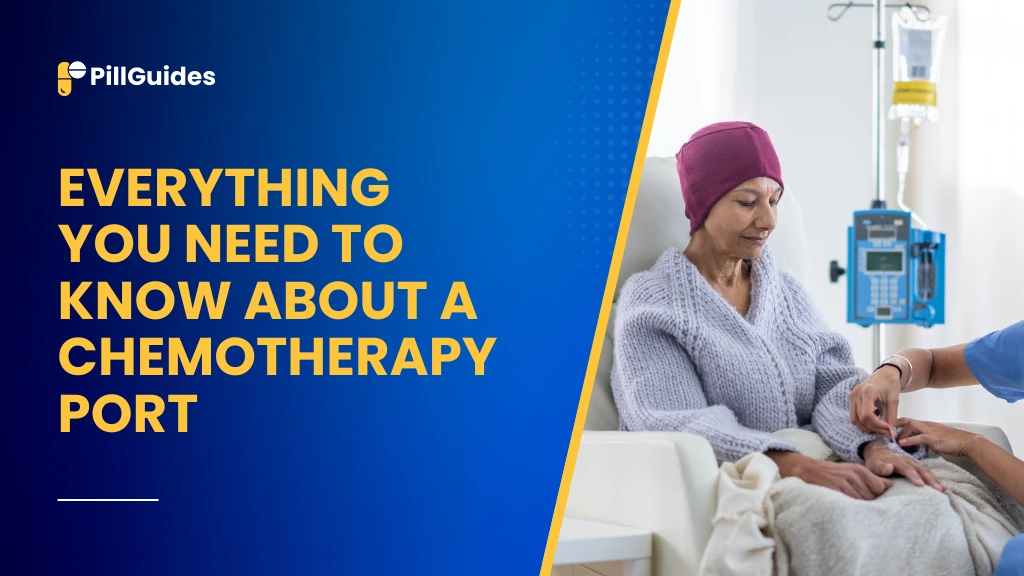When patients receive cancer treatment the process becomes easier through modern medical techniques. One such innovation is the chemotherapy port. A medical tool that decreases treatment pain and makes it simpler for patients and medical staff with repeated chemotherapy.
In this detailed guide, we’ll cover everything about chemotherapy ports: This guide explains how chemistry ports help patients with cancer treatment. It describes their features, functions, positive effects, safety issues, and necessary care steps. After completing this content you will understand the medical advantage of this tool.
What is a Chemotherapy Port?
A chemotherapy port known as a port-a-cath goes beneath the skin for painless medical device placement on either the chest or upper arm region. A chemotherapy port offers medical teams direct access to veins to help them give treatments like drugs or take blood samples.
Key Features of a Chemotherapy Port:
- Port Body: Doctors and nurses use this small round plastic or metal device under the skin for medical treatments.
- Catheter: A tiny flexible line inside the port delivers fluids to a major vein through this tube.
- Access Point: Doctors can place a needle into this port to give medicine or take blood samples.
The device is made for repeated access when a patient receives chemotherapy.
How Does a Chemotherapy Port Work?
The chemotherapy port is surgically implanted during a minor outpatient procedure:
- Preparation: Your doctor will review your medical records and the medical team will show you how the treatment works. We use local anesthesia to reduce pain in the area.
- Insertion: Doctors open your chest area or arm to place the port directly under your skin. The medical team puts the catheter into the superior vena cava vein during the procedure.
- Closure: The surgical cut is sealed using medical thread or sticky tape.
After surgical placement the port lets doctors send chemotherapy drugs directly into your bloodstream. You will no longer need to have needles stuck into your arm veins during regular treatment.
Benefits of a Chemotherapy Port
A chemotherapy port offers many benefits for people receiving long-term treatment.
- Reduced Pain and Discomfort: You may suffer much pain and scar your veins when healthcare staff inserts IV lines many times. A port eliminates this issue.
- Preservation of Veins: lasting needle sticks can weaken the location of veins and harm them over time. Using a port prevents damage to your veins.
- Convenience: Points of entry make delivering chemotherapy and blood draws easier, reducing the time patients spend in the hospital.
- Lower Infection Risk: The small number of infections seen in ports depends on the correct handling of these devices.
- Long-Term Use: The medical technology can work with patients throughout their long treatment phases without needing replacement.
Caring for Your Chemotherapy Port
To maintain good port performance you need to follow recommended care practices that protect you from treatment issues.
Tips for Port Care:
- Cleanliness is Key: Keep the area clean and dry. Work with your doctor when cleaning the area around the port.
- Flushing the Port: To prevent blood clots from forming, your port needs to be routinely flushed with salt water. A medical professional performs this task.
- Avoid Heavy Lifting: You should minimize chest and arm pressure activities to stop the catheter from moving.
- Monitor for Infections: Check for changes around your port including redness, swelling, and tenderness then tell your doctor if you notice infection symptoms.
- Protect During Bathing: Place a waterproof cover over the port area before your shower to keep it dry.
By following these recommendations you keep your port working well and decrease the chance of problems.
Potential Risks and Side Effects of a Chemotherapy Port
Chemotherapy ports create many advantages but you need to know about their possible dangers and problems.
Common Side Effects:
You may experience light pain from the implant area following your treatment.
The blood vessel insertion space develops inflammation or dark spots.
You will face some pain when your wound starts to heal.
Serious Risks:
- Infection: When bacteria enter the port opening it becomes a critical threat to your health.
- Blood Clots: The tubing material inside the port sometimes forms blood clots.
- Port Malfunction: Rarely does the port system fail and need to be replaced.
Contact your medical professional right away about the pain that does not go away, a fever, or swelling that keeps growing.
How Long Does a Chemotherapy Port Last?
The chemotherapy port system remains functional during extended treatment periods because it is made to stay in your body safely for months and up to years. After treatment ends doctors can easily take out the port during an office visit.
Conclusion
A chemotherapy port helps patients experience cancer treatment in ways that feel less painful and run more smoothly. Using a port helps patients receive chemotherapy treatment easily since they avoid painful needle sticks and protect their veins. Under expert medical supervision and regular monitoring, a port device delivers safe treatment results. Talk to your doctor about if a chemotherapy port belongs in your specific treatment plan.
Disclaimer
This article is for informational purposes only and should not replace professional medical advice. Always consult your doctor for specific guidance regarding your health or treatment options.
Read More: Treatment for IBC Breast Cancer: A Complete Guide
FAQs
Why do people use chemotherapy ports?
A chemotherapy port makes drug administration easier and lowers the number of needle sticks while protecting the veins from damage during treatment.
How long does it take to recover after getting a port?
Most patients recover within a few days after the procedure. Mild soreness is common, but normal activities can usually be resumed within 24-48 hours.
Are there special exercise rules for people with chemotherapy ports?
Do your usual activities but stay away from activities that stress your chest or require lifting heavy objects until your doctor says it’s safe. Talk to your doctor about what kind of exercise you should do.
How can I tell if my port area shows signs of infection?
An infected port area will show signs like a red or swollen patch with warm skin and discharge and may bring fever. Contact your doctor straight away if you experience these symptoms.
Can you see the medication port through your skin surface?
The small port device creates only a minimal visible lump you may feel when you touch your chest area.










